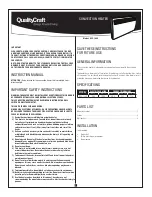
5 Installation
Installation and operation manual
17
LRMEQ+4BY1
Air-cooled refrigeration condensing unit
4P545024-1 – 2018.09
5.4.4
To perform a leak test
The leak test must satisfy the specifications of EN378‑2.
To check for leaks: Vacuum leak test
1
Evacuate the system from the liquid and gas piping to
–100.7 kPa (–1.007 bar)(5 Torr absolute) for more than 2 hours.
2
Once reached, turn off the vacuum pump and check that the
pressure does not rise for at least 1 minute.
3
Should the pressure rise, the system may either contain
moisture (see vacuum drying below) or have leaks.
To check for leaks: Pressure leak test
1
Break the vacuum by pressurising with nitrogen gas to a
minimum gauge pressure of 0.2 MPa (2 bar).
▪ Never set the gauge pressure of the
high pressure section
of the system higher than the maximum operation pressure
of 4.0 MPa (40 bar).
▪ Never set the gauge pressure of the
low pressure section
of the system higher than the design pressure of the indoor
unit.
2
Test for leaks by applying a bubble test solution to all piping
connections.
3
Discharge all nitrogen gas.
NOTICE
Make sure to use a recommended bubble test solution
from your wholesaler. Do not use soap water, which may
cause cracking of flare nuts (soap water may contain salt,
which absorbs moisture that will freeze when the piping
gets cold), and/or lead to corrosion of flared joints (soap
water may contain ammonia which causes a corrosive
effect between the brass flare nut and the copper flare).
5.4.5
To perform vacuum drying
To remove all moisture from the system, proceed as follows:
1
Evacuate the system for at least 2 hours to a target vacuum of
–100.7 kPa (–1.007 bar)(5 Torr absolute).
2
Check that, with the vacuum pump turned off, the target
vacuum is maintained for at least 1 hour.
3
Should you fail to reach the target vacuum within 2 hours or
maintain the vacuum for 1 hour, the system may contain too
much moisture. In that case, break the vacuum by pressurising
with nitrogen gas to a gauge pressure of 0.05 MPa (0.5 bar)
and repeat steps 1 to 3 until all moisture has been removed.
4
Depending on whether you want to immediately charge
refrigerant through the service port of the liquid stop valve, or
first pre-charge a portion of refrigerant through the liquid line,
either open the outdoor unit stop valves, or keep them closed.
See
"5.6.3 To charge refrigerant" on page 18
for more
information.
5.5
To insulate the refrigerant piping
After finishing the leak test and vacuum drying, the piping must be
insulated. Take into account the following points:
▪ Make sure to insulate the connection piping and refrigerant piping
branching entirely.
▪ Be sure to insulate the liquid and gas piping (for all units).
▪ Take the following into account when determining the insulation
thickness:
LRMEQ*
LRLEQ*
Liquid pipe minimum temperature
5°C
0°C
LRMEQ*
LRLEQ*
Gas pipe minimum temperature
–20°C
–45°C
Condensation might form on the surface of the insulation.
▪ If there is a possibility that condensation on the stop valve might
drip down into the indoor unit through gaps in the insulation and
piping because the outdoor unit is located higher than the indoor
unit, this must be prevented by sealing up the connections. See
below figure.
a
b
a
Insulation material
b
Caulking etc.
5.6
Charging refrigerant
5.6.1
Precautions when charging refrigerant
WARNING
▪ Only use R410A as refrigerant. Other substances may
cause explosions and accidents.
▪ R410A contains fluorinated greenhouse gases. Its
global warming potential (GWP) value is 2087.5. Do
NOT vent these gases into the atmosphere.
▪ When charging refrigerant, always use protective
gloves and safety glasses.
NOTICE
If the power of some units is turned off, the charging
procedure cannot be finished properly.
NOTICE
Before starting charging procedures, check if the 7‑LEDs
display is as normal (see
"6.1.4 To access mode 1 or 2" on
page 23
). If a malfunction code is present, see
"8.1 Solving problems based on error codes" on page 27
.
NOTICE
In case of maintenance and the system (outdoor unit+field
indoor units) does not contain any refrigerant any
more (e.g., after refrigerant reclaim operation), the unit has
to be charged with its original amount of refrigerant (refer
to the nameplate on the unit) and the determined additional
refrigerant amount.
5.6.2
To determine the additional refrigerant
amount
INFORMATION
For final charge adjustment in a test laboratory, contact
your dealer.
INFORMATION
If only showcase units are used, parameter
B=0
. If only
blower coils will be used, parameter
A=0
.
INFORMATION
If
R≤0
, there is no need to charge/recover additional
refrigerant.
Summary of Contents for LRLEQ3BY1
Page 33: ......
Page 34: ......
Page 35: ......
Page 36: ...4P545024 1 2018 09 Copyright 2016 Daikin 4P441336 1 0000000J 4P545024 1 0000000I...
















































